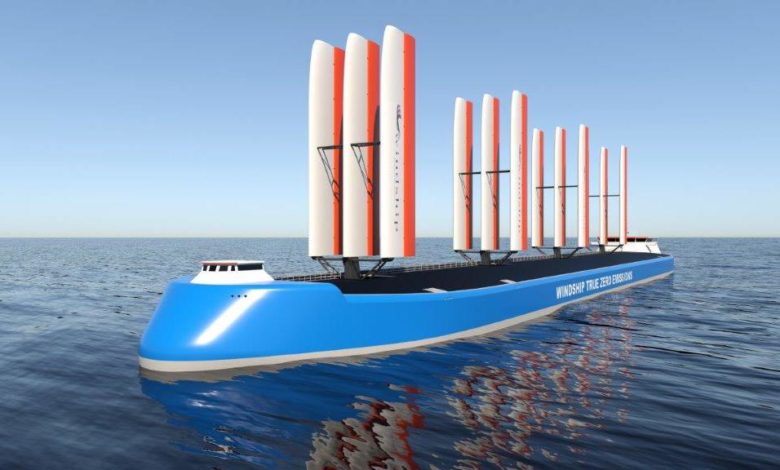Windship Technology claims new design is the ‘Tesla’ of the seas

Wind-powered merchant shipping developments are hitting the industry with ever greater momentum. This week Windship Technology, a British company, unveiled its designs of what it claims can become the Tesla of the seas while announcing an investment partnership with class society, DNV GL.
The design – developed ands tested in Southampton – features a triple-wing rig as well as a new diesel electric ship drive system that eliminates CO2, NOX, SOX and particulate matter. The futuristic looking ship also incorporates large solar arrays, carbon capture, optimised hull shapes and specialised weather routing software.
The 48 m high Windship Technology rig is stowable on deck to aid port navigation and cargo handling.
DNV GL has decided to come onboard as an investor and will carry out verification of the ship design.
Per Marius Berrefjord, a senior vice president at DNV GL, commented: “We are delighted to be working with such experienced professionals at Windship Technology in a project which aims to help transform the entire shipping industry to true zero. We will work closely with the project team in a fully transparent manner.”
“The Windship Technology True Zero Emission solution is presently the only viable and most economical zero emission project for ocean-going bulk carrier and oil tanker ships,” Windship claimed in a release this week.
Windship Technology is now looking to cement commercial partnerships with major shipowners, operators and investors.
Lars Carlsson, director of Windship Technology, commented: “Working with DNV is a major step towards proving true zero emission status. The industry cannot sit back any longer. The clock is ticking and regulation will force a new approach for an industry that is traditionally hesitant to change. Shipping is not fit for purpose in the future. Shipping and oil companies are the only major industries still increasing their emissions and must change and think differently if it is to have any hope of reaching the emissions targets set out in law.”
In related wind power news, Dutch sailing cargo company EcoClipper has released a life cycle analysis (LCA), which examines their proposed vessel’s impact in the transport industry.
The LCA shows the EcoClipper500 design will produce 80% less emissions than a containership over its lifetime when both are carrying the same cargo tonnage.
Size constraints however could prover a hurdle for EcoClipper. When pressed by Splash, a spokesperson revealed the maximum carrying capacity of the EcoClipper500 is an equivalent of almost 20 teu, although the planned ships will mainly carry pallets.
EcoClipper claims most sustainable way to transport cargo and passengers is using a traditional design of vessels, the Clipper ship, with square-rig sails. The company is now pitching for investors to build its first ship.
EcoClipper was founded in 2018 by Jorne Langelaan, a sail cargo expert and co-founder of shipping company Fairtransport. The plan is for EcoClipper ships to sail on four shipping lines with fixed schedules. A similar initiative is further down the track in France with a number of French shippers signing on to a sail powered cargo venture set to ply the Atlantic soon.


All these wind powered concepts are at the mercy of very variable wind conditions in transit. The likelihood of being able to scale up this technology set to equivalent conventional vessels looks remote. These concepts or similar were around decades ago but nothing materialized.
All the claims on emissions and commercial performance need to be raked over forensically.,
The claimed elimination of CO2 and other emissions using diesel electric power really does need to be looked into. Hot exhaust gases are a product of the combustion process.
The maritime industry remains the only space in business (afaik!) where marketing your product equates to trash talking and shaming your customers. Good luck with the “CO2-free” diesel electric though!